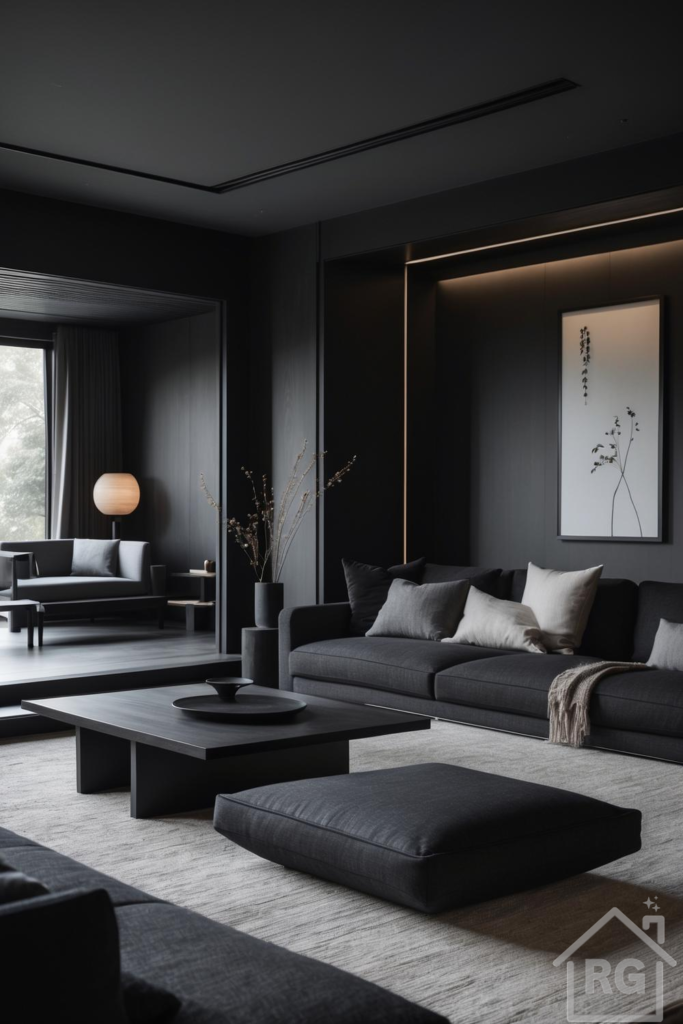
The Allure of Dark Japandi: Where Moody Meets Minimalist
Japandi design, the harmonious blend of Japanese minimalism and Scandinavian functionality, has captivated the design world. But what happens when this serene style embraces the shadows? Enter Dark Japandi – a sophisticated, moody interpretation that swaps light woods and bright whites for deep tones, rich textures, and an atmosphere of profound tranquility. This stunning living room exemplifies the power and elegance of this emerging style.
Deconstructing the Dark Japandi Aesthetic
Achieving the Dark Japandi look involves a careful balance of elements. It’s not merely about painting walls black; it’s a curated approach that prioritizes atmosphere, texture, and intentionality. Let’s break down the key components seen in this space:
- Dominant Dark Palette: The foundation is built upon deep, enveloping colors. Matte black or charcoal grey walls create an intimate, cocooning effect. Furniture follows suit, with dark upholstery and stained wood. The key is layering shades of black, grey, and deep brown (#1A1A1A, #333333, #4D4D4D) to add depth and prevent flatness.
- Emphasis on Texture: When color is restrained, texture becomes paramount. Notice the interplay of textures: the soft weave of the area rug (#B3B3B3), the smooth matte finish of the walls and coffee table, the tactile fabric upholstery on the sofas and ottoman, the subtle grain of dark wood accents, and the smooth coolness of ceramic accessories. These variations engage the senses and add warmth to the dark palette.
- Minimalist Furniture Forms: True to Japandi principles, furniture features clean lines and low profiles. The sofas are substantial yet simple, the coffee table is geometric and grounded, and the ottoman provides flexible seating or surface space. Functionality and uncluttered forms are essential.
- Strategic Lighting: Lighting is crucial in a dark space. Instead of harsh overhead lights, Dark Japandi utilizes layered lighting. Subtle recessed linear lighting washes the wall, adding architectural interest and ambient glow (#A67C52). A sculptural floor lamp provides task lighting and acts as a focal point. Natural light, though potentially limited, is softened by simple window treatments.
- Natural Elements & Wabi-Sabi: Touches of nature prevent the space from feeling sterile. Dried branches in a simple ceramic vase introduce an organic element. The artwork, featuring minimalist botanical forms on a light background (#D9D9D9), provides visual relief and adheres to the Wabi-Sabi appreciation of imperfection and natural simplicity.
How to Implement Dark Japandi in Your Living Room
Inspired to create your own moody sanctuary? Here are practical tips:
- Start with the Walls: Choose a deep, matte shade like charcoal, deep grey, or even a muted forest green or navy. Matte finishes absorb light, enhancing the cozy, enveloping feel. Consider adding texture with limewash or subtle wall paneling as seen here.
- Layer Dark Tones: Don’t use just one shade of black or grey. Mix charcoal sofas with black tables, dark wood accents, and varying grey textiles (cushions, throws). This creates visual interest and sophistication.
- Introduce Contrasting Textures: Combine smooth surfaces (metal, ceramic, matte paint) with rougher or softer ones (woven rugs, linen or boucle upholstery, knitted throws, wood grain). This tactile variety is essential for warmth and depth.
- Select Low-Profile, Simple Furniture: Opt for pieces with clean lines and natural materials (dark wood, metal). Avoid overly ornate or bulky items. Functionality and form should be balanced.
- Plan Your Lighting Carefully: Incorporate multiple light sources. Dimmable ambient lighting (like recessed strips or track lighting), task lighting (floor lamps, table lamps), and accent lighting (to highlight artwork or architectural features) are key. Choose warm bulbs (around 2700K) to enhance the cozy atmosphere.
- Accessorize Mindfully: Follow the ‘less is more’ principle. Choose a few high-quality, meaningful items. Think simple ceramic vases, minimalist artwork, sculptural objects, and natural elements like dried botanicals or stones. Use lighter-toned accessories (#B3B3B3, #D9D9D9) sparingly for contrast.
- Don’t Forget Greenery (or Dried Botanicals): While lush green plants might contrast too sharply, consider deep green foliage or, as seen here, dried branches or grasses. They add life without disrupting the muted palette.
- Balance with Lightness: Ensure some elements provide visual relief. A lighter rug, light grey or off-white cushions, or artwork with a pale background can prevent the space from feeling oppressive.
The Psychology of Dark Design
Dark interiors often evoke feelings of safety, intimacy, and sophistication. They create a retreat from the outside world, encouraging relaxation and introspection. By combining these deep tones with the minimalist and natural principles of Japandi, the result is a space that feels both grounding and incredibly chic. It’s a style that invites you to slow down, appreciate the subtleties of texture and form, and find peace in serene surroundings.
This dark Japandi living room is more than just a design trend; it’s a statement in mindful living, proving that darkness can be comforting, minimalism can be luxurious, and style can be deeply serene. Ready to embrace the elegance of the shadows?
